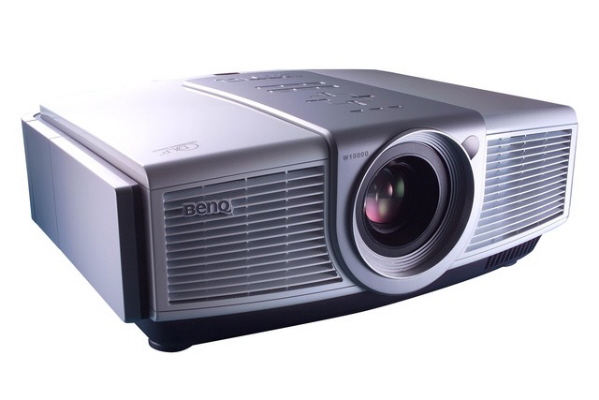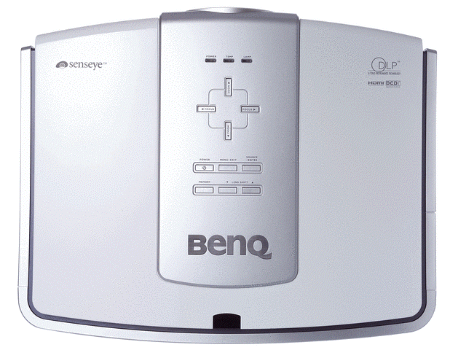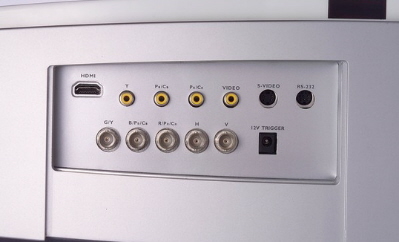Introduction
BenQ has
been one of the more elusive projector manufacturers for the home theater
market. They are huge in the world of professional projectors for business
use, but have only dabbled a bit in the home theater department. But if youíve
been lucky enough to experience what they bring to the home theater projector
world, youíd know they packed in state of the art features into very
attractively priced projectors.
For this
review I received the W10000. This is a full 1920x1080 Digital Light
Processing (DLP) home theater projector. The W10000 has a lot of features that
Iíve found lacking in most of the 1080p designs Iíve used so far and comes in
at a price point that is almost too good to be true.
The W10000
The
W10000 is very similar in form and function to BenQís previous 720p flagship
DLP design, the PE-8720. The chassis is on the larger side and unfortunately
is white in color. This is probably one of my biggest complaints with the
projector as Iím not a fan of white chassis on home theater projectors but if
this is one of the bigger complaints BenQ must be doing a pretty good job
elsewhere.

The
chassis exhausts heat through the front, and puts out a decent amount of warm
air. The cooling system is very effective though and this is one of the
quietest projectors Iíve ever had the pleasure of using. Another huge plus is
the lack of noise in high lamp mode. I used this mode a few times during my
review and I never heard an increase in noise output from the fan. Normally
high lamp mode sends most projectors into jet engine noise levels (well maybe
not that bad, but enough to be too distracting for quiet movie passages).
Surprisingly BenQ even added a quieter mode available through its service
menu, but I never saw a reason to use it. This mode slows the color wheel down
a bit in case the whine is getting to you, I never noticed it.
Like most
of the projectors out there the W10000 has a collection of interface tools
right on top including buttons for the menu, power, and navigational keys. I
never used these keys as I had the projector ceiling mounted during the
review.

The back
panel is pretty customary and includes a single HDMI input, a component video
input, a RGB+HV input complete with BNC connections, an S-Video Input and a
composite input. Youíll also find an RS-232 connection for remote systems.
The
W10000 offers full remote control of nearly all of its features. You can
adjust zoom, focus and vertical lens shift all from the remote control. I
havenít played with too many 1080p DLP designs that offer this feature. I must
say the ability to focus the projector while standing right up at the screen
is a huge plus. I donít have to rely on someone else standing up there to tell
me when itís dialed in and Iím not the biggest fan of trying to eyeball it
from the projector 15 feet away. Iíve heard criticisms about powered focus
designs and not being able to focus in as tight as a manual lens design, but
that certainly wasnít the case here. The 10000ís powered focus allowed me to
focus in tight enough to clearly resolve each pixel and the dimple in the
center of the digital mirror device (DMD). While that doesnít sound like much
Iíve been around enough projectors that canít even come close to that. Next
time youíre around a projector take a look at the pixels on the screen and
youíll get an idea of what I mean.

The zoom
and lens shift worked well to. While I would always like to see horizontal
lens shift included as well, BenQ has included a nice range of movement with
its lens shift abilities. There is a downside though. Because of the catís eye
like iris the projector employs, I saw some vignetting at times. I had to
shift the image down a bit since I mount the projector above the screen and
this caused the image to have some slight darkening in the lower left corner.
Since the iris has nearly 30 positions I was able to open it up just enough to
eliminate the issue, but this in turn sacrifices a bit of contrast. Some
people may never have this issue but it is something to think about if you
need to use a lot of lens shift.
The
projector has a bit of a limited throw and is on the longer side. I know some
may have issues getting this projector to work with their setups but I usually
find this the case with most of the designs out there. I had no problem
filling up my reference Stewart Filmscreen 120Ē Studiotek 130, but I have a
pretty long room (23 feet).
The
W10000 offers some features that most of the 1080p DLP market are lacking.
This projector has an ISF mode allowing calibrators to dial in more than just
the cursory adjustments, making this one of the most calibration friendly
designs Iíve seen yet. It also works with constant height setups. BenQ has
included modes to use with an anamorphic lens and is even certified for
Panamorph lens applications.
Click Here to Go to Part II.